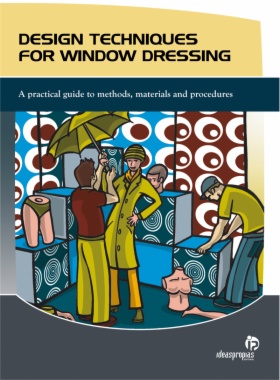A good professional window dresser must be innovative and creative, intuitive and resourceful, i.e., an artist with a technical and commercial base. They must also possess artistic, marketing and technical skills. Moreover, an excellent sense of colour and light and an ability to create scenic displays is also important.
- 1. The window display
- 1.1. Introduction
- 1.2. Brief background history
- 1.3. Function
- 1.4. Objectives
- 1.5. Types of window display
- 1.5.1. Types of window display according to location
- 1.5.2. Types of window display according to presentation
- 1.5.3. Window displays for brand advertising
- 1.5.4. Window displays that do not exhibit merchandise or products
- 1.5.5. Types of window display according to product
- 1.6. What is a window dresser?
- 1.7. Summary of content
- 2. Basic principles of window dressing
- 2.1. Introduction
- 2.2. Factors that determine the composition of a window display
- 2.3. Basic principles of a window display: simplicity; reliefs; clarity; grouping and empty spaces; sharpness; dominance; homogeneity; luminosity
- 2.4. Key characteristics: visibility; order and unity; visual coherence; creativity and surprise
- 2.5. Principles of composition: balance, weight, shape, space and memory
- 2.5.1. Balance
- 2.5.2. Weight
- 2.5.3. Shape
- 2.5.4. Space
- 2.5.5. Memory
- 2.5.6. Composition proposals
- 2.6. Summary of content
- 3. Basic elements of window dressing. Colour and light. Lines, surfaces and volumes. Structural elements
- 3.1. Introduction
- 3.2. Colour
- 3.2.1. The perception of colour
- 3.2.2. Characteristics of colour: tone, luminosity (paleness), saturation (intensity) and hue
- 3.2.3. Classification of colours: basic, complementary, binary, cool and others
- 3.2.4. The psychology of colour
- 3.2.5. Colour selection criteria: nature and characteristics of the articles; the shop’s style and clientele; season; fashion; number of colours and performance
- 3.3. Light and illumination
- 3.3.1. Light and the window display
- 3.3.2. Lighting systems
- 3.3.3. Shadow and colour
- 3.3.4. Appropriate light strength for a window display
- 3.3.5. Types of lights
- 3.4. Lines, volumes and surfaces
- 3.5. Structural elements: windowpanes, walls, backgrounds (open, half open, closed) and display bases
- 3.5.1. Structural elements
- 3.5.2. Fixings
- 3.5.3. Window display work tools
- 3.6. Summary of content
- 4. Definition of a window display
- 4.1. Introduction
- 4.2. Arrangement
- 4.2.1. Symmetrical
- 4.2.2. Asymmetrical
- 4.2.3. Rhythmical
- 4.3. Positioning
- 4.3.1. Frontal
- 4.3.2. Oblique
- 4.3.3. Fanned
- 4.4. Composition
- 4.4.1. Geometrical
- 4.4.2. Linear
- 4.4.3. Circular
- 4.4.4. Pyramidal
- 4.5. Initial elements to consider
- 4.5.1. Coverings
- 4.5.2. Signs. Functions: attractive, informative and decorative
- 4.5.3. Selection of text and wording for signs
- 4.5.4. Signage and screen printing
- 4.6. Labels. Information (price, composition, size, brand and other characteristics) and regulations. Dimensions and colours. Location
- 4.7. Interior decorations. Display accessories: function, types and selection criteria
- 4.7.1. Function
- 4.7.2. Display materials
- 4.7.3. Mobile elements, technical equipment and animation systems
- 4.7.4. Fixed elements
- 4.7.5. Living elements
- 4.7.6. Mannequins
- 4.7.7. Selection criteria
- 4.8. Creating the window display
- 4.8.1. Measuring the space
- 4.8.2. The idea
- 4.8.3. Implementing a project
- 4.8.4. Model
- 4.8.5. Budget
- 4.8.6. Completion time
- 4.8.7. Decoration and materials (wood, plastic, metal, cord, card, paint, paper, plaster, fabric and cork)
- 4.9. Product display schedule
- 4.9.1. Preparing the products to be displayed
- 4.9.2. Scheduling
- 4.9.3. Displaying the products: the assembly
- 4.9.4. Product movement/renewal. Window display rotation
- 4.10. Special sales: sales, start of season, end of year
- 4.11. Performance and effectiveness of the window display: efficiency ratios and indexes
- 4.12. Summary of content
- 5. Drawing and design
- 5.1. Introduction
- 5.2. Theory of visual communication. The meaning of design
- 5.3. Composition and design
- 5.3.1. Definition
- 5.3.2. General concepts and combinations
- 5.3.3. Sign. Symbol. Emblem. Anagrams and diagrams. Brands and logotypes
- 5.3.4. Visual elements: three-dimensional
- 5.3.5. The design method
- 5.4. Artistic drawing and technical drawing
- 5.5. Summary of content
- SUMMARY
- Bibliography

